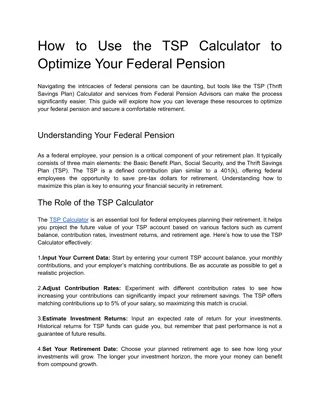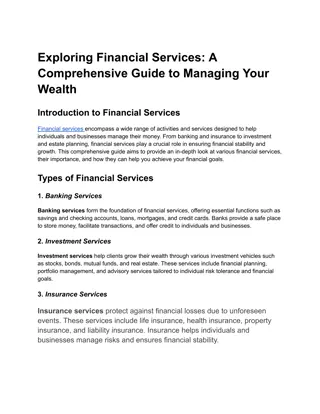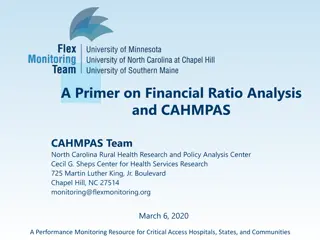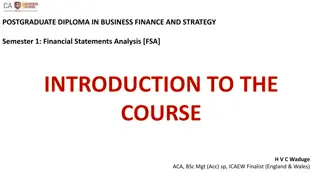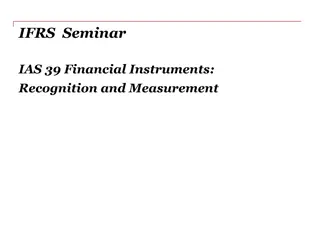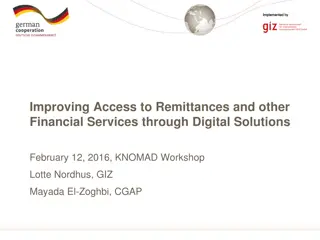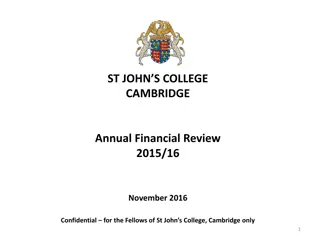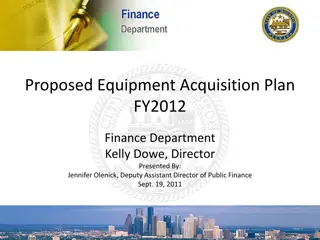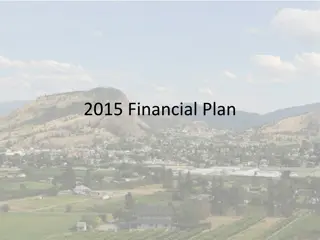
Creating Your Financial Plan: Assess, Prioritize, Achieve
This module focuses on creating a comprehensive financial plan by assessing your current situation, prioritizing goals, and implementing strategies to achieve them. The content covers topics such as record-keeping, IRS publications, budgeting, and debt management. The project team, led by experts from various universities, provides valuable insights and tools to help individuals take control of their finances.
Download Presentation

Please find below an Image/Link to download the presentation.
The content on the website is provided AS IS for your information and personal use only. It may not be sold, licensed, or shared on other websites without obtaining consent from the author. If you encounter any issues during the download, it is possible that the publisher has removed the file from their server.
You are allowed to download the files provided on this website for personal or commercial use, subject to the condition that they are used lawfully. All files are the property of their respective owners.
The content on the website is provided AS IS for your information and personal use only. It may not be sold, licensed, or shared on other websites without obtaining consent from the author.
E N D
Presentation Transcript
Managing Money Curriculum Module 7: Creating Your Financial Plan Bringing it all Together 1
Project Team: Ruby Ward, Professor, Utah State University Trent Teegerstrom, Associate Director of Tribal Extension, University of Arizona Karli Salisbury, Research Associate, Utah State University Kynda Curtis, Professor, Utah State University Staci Emm, Extension Educator and Professor, University of Nevada Reno Carol Bishop, Extension Educator and Associate Professor, University of Nevada Reno Acknowledgments: Vicki Hebb, reviewing content, and Russ Tronstad and Stuart Nakamoto, content. This material is based upon work that is supported by the National Institute of Food and Agriculture, U.S. Department of Agriculture, under award number 2013-38640-22175 through the Western Sustainable Agriculture Research and Education program under subaward number EW14-017. USDA is an equal opportunity employer and service provider. Any opinions, findings, conclusions, or recommendations expressed in this publication are those of the author(s) and do not necessarily reflect the view of the U.S. Department of Agriculture. 2 Each university is an affirmative action/equal opportunity institution
Outline Review Progress on Exercises Creating Your Plan Current Situation: Assess Where You Are Prioritizing Goals Developing Plan for Goals Plan Checklist/Overview 3
Review Progress on Exercises Tracking expenses Developing budget Developing goals Goals Note: Can refer back to modules and individual exercise if wanted 6
Creating Your Plan Assessment of your current progress and situation Analyze assessment to see what needs work Prioritize goals with plan to achieve them Review your plan and develop list of additional help 7
Assessment of Current Situation Do I have a budget? Do I have a method of tracking my income and expenses? Do I have an emergency fund? How many months are saved for ? Do I need to boost this fund? How much do I need? Where is this invested? How much debt to I have? Do I have a list of all my loans/debt? Do I need to pay down unsecured debt (credit cards)? Do I need to refinance a secured loan (home mortgage)? 8
Assessment of Current Situation What is my credit score? Do I need to boost my credit score? Do I need to save for retirement? How much do I need to save for retirement? Do I need to boost this amount? How much should I save each month? Do I need to save for education? Do I need to have an education fund for myself and/or my children? How much do I need? How much do I need to save each month? 9
Assessment of Current Situation Other Savings Goals? Do I have more savings goals? How much will I need? How long do I have to save? How much will I need to save each month? 10
Analyze Your Assessment Based off the assessment, make a list of what could be improved. How much money will it take each month? Look at all your goals and determine how much money each will take per month. Make a list with monthly amounts. Analyze your budget to see how much is available to use for both debt reduction and savings. 11
Prioritize Your Goals If the amount needed for all your goals is more than is available in your budget, you will need to prioritize your goals. What is most important to you right now? If you try doing too many things at once, you may not achieve any of them. Work on what you determine is most important, you will be more motivated. Once you have achieved a goal, you can work on another or set more. You don t have to do everything at once. However, try to make progress. 12
Develop a Plan to Achieve Your Goals Modify both your budget and goals to create a plan that will work Review tradeoffs in earlier modules To have more money for goals you either need to: Spend less on something (modify your budget),or Earn more income You may need to modify your goals If you take longer to achieve them, it will cost less per month 13
Review Your Plan Are your goals obtainable and reasonable? Can you stick to your budget? Is it doable over time? How will you track your progress? How will you hold yourself accountable? How will you celebrate success? How will you stay motivated? What additional help do you need? Career Counseling Other Counseling Where can you find help? 14
Monitoring and Modifying Your Financial Plan You will need to continue to monitor your progress. Modifying your plan when there are big changes in your situation. Life events (marriage, death, divorce, children etc.) Change in employment Should have a plan for the unexpected which does not need to be modified continually. 15
Money Management Review Module 1: Record Keeping Track and record income and expenses often. Module 2: Loans and Credit Use the MyFi app to become more savvy about loans and credit cards. Module 3: 5 C s of Borrowing Know the factors that lenders use to approve loans. Module 4: Credit Scores Know the components of a credit score, and how to start improving your score. 16
Money Management Review Module 5: Savings and Budgeting Budget for goals and savings. Module 6: Building a Better Budget Reach your budget goals while still meeting your needs. Understand trade-offs and wants vs. needs. Module 7: Creating Your Financial Plan Analyze your budget. Find areas that need improvement and create a plan to improve those areas. 17
Homework Finish and polish your plan Prepare to present your financial plan to others What additional information would you like? Workforce services Increasing income Loans and grants available 18
Thank you! 19




